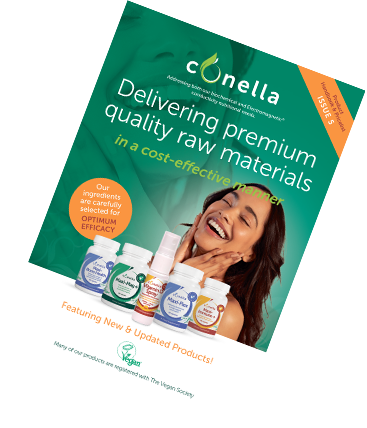What is arthritis and how does it develop?
Arthritis is an inflammation of the joint (from Greek arthron – joint and itis – inflammation). Whilst inflammation is a normal physiological response to an injury, it can become chronic and cause problems when it is not switched off once the healing process is completed. Symptoms include joint pain, tenderness, stiffness and restricted movement and their severity can range from mild to disabling.
The most common form of arthritis is osteoarthritis, which affects around 9 million people in the UK alone, and usually develops after the age of 40. The exact causes are unknown but are most likely multifactorial. Osteoarthritis is characterised by a breakdown of the cartilage that lines and protects the joints, leading to the formation of bony spurs and inflammation. Osteoarthritis most commonly affects the weight-bearing joints of knees, hips, and back, as well as the joints of the hands, and is generally thought of as being due to “wear and tear”.1
The second most common form of arthritis is rheumatoid arthritis, an autoimmune condition that affects not only the joints but the whole body. It often starts in the small joints of the hands.
Conventional treatment and management of osteoarthritis
Conventional treatment of osteoarthritis is based on symptomatic pain relief, e.g. through painkillers like paracetamol, and suppressing inflammation, generally through non-steroidal anti-inflammatory drugs (NSAIDs) such as ibuprofen, celecoxib, naproxen and diclofenac, either topically or orally. These drugs carry health risks with regards to the liver, cardiovascular and digestive systems. Due to their detrimental effect on the lining of the digestive tract, potentially causing inflammation and ulcers, proton pump inhibitors are usually prescribed alongside the NSAIDs, with all the negative effects they have on digestion.
Targeted exercise and physiotherapy are generally recommended to support and strengthen the affected joints. Where people are overweight or obese, weight loss through diet and exercise is encouraged to take weight off the affected joints. In severe arthritis, steroid injections are sometimes used, and surgical treatment, including full joint replacements, are used as a last resort.2
A holistic approach to arthritis
A naturopathic approach to arthritis aims at reducing inflammation and nourishing the joints through nutrition and lifestyle, whilst also addressing structural issues through specific bodywork modalities such as osteopathy, chiropractic, podiatry, and Alexander Technique. Reducing weight in overweight and obese clients is encouraged, not only to reduce pressure on the joints but also to reduce fat tissue which has pro-inflammatory properties.
Adopting an anti-inflammatory diet is crucial to reduce inflammation, and includes
- Eating plenty of vegetables and fruit, as well as including a variety of spices and herbs, for their plethora of anti-oxidant and anti-inflammatory compounds.
- Reducing sugar and refined carbohydrates, which increase levels of insulin which is pro-inflammatory.
- Getting a healthy balance of omega-3 to omega-6 fatty acids by avoiding refined vegetable oils and ensuring adequate intake of omega-3 fatty acids from oily fish or algal DHA.
- Excluding potential food allergens if food intolerances are suspected.
- Chronic inflammation is often associated with gut and/or toxicity issues, so gut health and/or detoxification pathways should be addressed as appropriate.
Nutrient support for healthy joints
A number of nutrients and botanicals have been studied and found beneficial in the management of arthritis.
Glucosamine
When it comes to osteoarthritis, glucosamine is probably one of the best-known and most researched supplements. Glucosamine is a constituent of the cartilage matrix of joints and as such thought of as a building block, although pharmacokinetic studies suggest that it may work by reducing inflammatory cytokines.3 Glucosamine has been shown to improve markers of cartilage turnover in patients with knee osteoarthritis in response to strength training.4
In 2005, a Cochrane review and meta-analysis of 25 clinical trials found that glucosamine was superior to placebo in relieving pain and improving function in patients with osteoarthritis.5 Since then more clinical trials have been published, with inconsistent results.3
There are two formulations of glucosamine: glucosamine sulfate, which is usually derived from shellfish, and glucosamine hydrochloride (HCl), a vegan alternative. Most clinical research has been carried out on glucosamine sulfate, but a trial in 2018 showed that both formulations were equally effective in relieving pain after 12 weeks of use in patients with osteoarthritis of the knee: a significant reduction in pain intensity of 4.27 (on a scale of 0-10) was seen in those receiving glucosamine sulphate with chondroitin and 3.58 in those receiving glucosamine HCl with chondroitin, the difference between the two formulations was not statistically significant.6
Unfortunately for patients and their CAM practitioners, glucosamine has become a victim of its own success and popularity: in 2016 the MHRA classified glucosamine products with dosages of 1,178mg or more per day as a medicine, meaning to qualify as a dietary supplement, products have to contain less than this amount7 which is less than the dose of 1,500mg per day used in most clinical trials.
Chondroitin
Glucosamine is commonly used in combination with chondroitin. Like glucosamine, chondroitin is a chemical found in the cartilage around joints. It is thought to support the processes involved in cartilage remodeling.8
A Cochrane review in 2015 found that chondroitin sulfate, either on its own or in combination with glucosamine, was more effective than a placebo in relieving pain in osteoarthritis patients.9 A more recent meta-analysis of 18 placebo-controlled clinical trials of chondroitin on its own in osteoarthritis found chondroitin to be effective in improving pain and function although, as with glucosamine, there were inconsistencies between studies.10 Studies have shown that chondroitin on its own is not only more effective than placebo but as effective as celecoxib (an NSAID) in improving pain and function11 and more so than celecoxib in improving cartilage volume loss.8
Chondroitin is usually derived from animal sources, such as shark cartilage, and as such unsuitable for vegans and vegetarians. Mythocondro® is a non-animal form of chondroitin sulfate which is obtained through a fermentation process. Whilst no clinical trials of Mythocondro® in arthritis are available as yet, pharmacokinetic studies have shown that it has a 43% higher bioavailability than an bovine-derived chondroitin sulfate.12
As mentioned above, chondroitin is commonly used alongside glucosamine, and a meta-analysis comparing glucosamine, chondroitin, glucosamine plus chondroitin, celecoxib and paracetamol found all five treatments to be better than placebo, with varying degrees of effectiveness for pain, stiffness and overall function.13
Curcumin/turmeric
Turmeric, Curcuma longa, has a long tradition of use, both as a culinary spice and in Ayurvedic medicine. It is renowned for its anti-inflammatory benefits, but has also been used for its antioxidant, anti-microbial and anti-cancer properties. The main active constituents of turmeric are curcuminoids, lipophilic polyphenols: curcumin (diferuloylmethane), demethoxy-curcumin, and bisdemethoxycurcumin. Turmeric’s anti-inflammatory properties are mediated through a variety of mechanisms, including modulation of cyclooxygenase-2 (COX-2), lipoxygenase and inducible nitric oxide synthase (iNOS) and inhibition of production of inflammatory cytokines.14
Curcuminoids tend to be poorly absorbed and have limited bioavailability, but despite this seem to have good clinical efficacy. It has been postulated that this may be due to curcumin metabolites possessing beneficial biological activities.15 A number of compounds and technologies have also been used to enhance bioavailability of curcuminoids, piperine from black pepper being well known in this respect. A clinical study showed that piperine increased bioavailability of curcumin by 2000%.16 This is of course also how turmeric is used in traditional South Indian cuisine: in combination with pepper.
There are numerous clinical trials showing benefits of curcumin in arthritis. A few recent meta-analyses showed that curcumin was more effective than placebo and as effective as NSAIDs in relieving pain and improving function in osteoarthritis patients, with a better safety profile than NSAIDs.17 18 For example, one study showed that curcuminoids (1,500 mg/day, enhanced with a black pepper extract, for 6 weeks) improved pain score from 9.9 to 6.1 (on a scale of 0-20) and function score from 31.8 to 18.7 (on a scale of 0-68), both of which were significantly better than placebo.19
Boswellia
Boswellia serrata, or its resin, is another plant that has a long history of use, both for religious and cultural ceremonies and for use in Ayurvedic medicine. Its oil is known as Indian frankincense. More than 200 compounds have been identified from the resin of which boswellic acid is considered to be the most important one. However, some studies have shown that crude extracts have stronger anti-inflammatory activity than purified boswellic acid, suggesting that other compounds may also play a role in Boswellia’s beneficial properties. As with turmeric, Boswellia extracts appear to exert their anti-inflammatory properties by affecting a number of inflammatory pathways.20
A systematic review and meta-analysis of seven studies showed significant benefits of Boswellia in osteoarthritis, improving pain, stiffness and function more so than placebo or comparator. In three of these studies, Boswellia was tested on its own versus placebo, in the other four it was combined with MSM, Elaeagnus or curcumin and tested against placebo or comparator (ibuprofen or glucosamine). The authors recommend a dosage of 100-250mg per day for at least 4 weeks to see clinical benefits.21 Three further studies which were not included in the above review also showed significant benefits in osteoarthritis.22 23 24
Ginger
Ginger, Zingiber officinale, is botanically closely related to turmeric. And, as with turmeric, it is the rhizome, the root structure, that has a long traditional use, both as a spice and in Ayurvedic medicine. Ginger is possibly best known for its use in nausea and vomiting, but has also been well researched for its anti-inflammatory properties.25
A 2015 meta-analysis of five randomised placebo-controlled trials showed that ginger was significantly more effective than placebo in relieving pain and improving disability in patients with osteoarthritis.26 A more recent meta-analysis, which only included two studies also found a significant effect of oral ginger extracts on pain but not function, but no effect of topical ginger preparations.27
EPA and DHA
Fish oils, providing the omega-3 essential fatty acids EPA and DHA, are well known for their anti-inflammatory properties, and have been shown to be of benefit in both rheumatoid and osteoarthritis.28
Flax seed oil contains alpha-linolenic acid (ALA) which can be converted to EPA and DHA, however, conversion appears to be low and may vary significantly between individuals.29 There are no clinical trials into the use of ALA from flax seed oil, or other vegetable oils, in arthritis.
Some scientists believe DHA to be an essential nutrient and vegans and vegetarians have lower DHA levels than omnivores.30 However, vegan sources of DHA are now readily available, where the DHA is sourced from algae. DHA can readily be converted to EPA, and both have anti-inflammatory properties. Whilst most studies on the benefits of omega-3 fatty acids in arthritis use fish oil supplements, DHA from algae has also shown to significantly improve symptoms and disease markers of rheumatoid arthritis.31
Palmitoylethanolamide PEA
Cannabidiol (CBD) oil has become a popular choice for pain related conditions but presents a legal conundrum due to being a substance derived from cannabis and the question over whether it may contain psychoactive substances. Palmitoylethanolamide, or PEA for short, is a natural substance also affecting the endocannabinoid system but without these problematic issues and several studies have shown good effects in neuropathic pain.
PEA has also shown promising results in arthritis. A recent double-blind placebo-controlled trial in osteoarthritis patients found a 33% improvement in pain and 53% improvement in overall symptom score after 8 weeks of taking 600mg PEA which was significantly better than placebo.33 For more on PEA, see link to log.
Combination products
As mentioned above, many botanicals appear to exert their effect through a number of different mechanisms. In nutritional practice we often see that combining nutrients and/or botanicals may have synergistic effects, probably through a variety of mechanisms that complement each other. Whilst research into synergistic effects as such has not been done, some studies have evaluated combination products in arthritis with good results.
For example, a study comparing a combination of curcumin and Boswellia showed the combination to be more beneficial that the NSAID celecoxib in patients with knee osteoarthritis.23 Another study showed that glucosamine combined with fish oils relieved symptoms for more osteoarthritis patients than glucosamine alone.32
Summary
Arthritis, in particular osteoarthritis, is a condition commonly seen in practice which can significantly reduce a client’s quality of life. Being a chronic inflammatory condition, naturopathic approaches are well placed to support these clients long term through dietary and lifestyle changes, and a tailored supplement programme.
References
1. Imm, N. Osteoarthritis. patient.info https://patient.info/doctor/osteoarthritis-pro (2017).
2. NICE. Osteoarthritis: care and management. https://www.nice.org.uk/guidance/cg177/chapter/1-Recommendations#non-pharmacological-management-2 (2014).
3. Eriksen, P. et al. Risk of bias and brand explain the observed inconsistency in trials on glucosamine for symptomatic relief of osteoarthritis: a meta-analysis of placebo-controlled trials. Arthritis Care Res. (Hoboken). 66, 1844–1855 (2014).
4. Petersen, S. G. et al. Glucosamine but not ibuprofen alters cartilage turnover in osteoarthritis patients in response to physical training. Osteoarthr. Cartil. 18, 34–40 (2010).
5. Towheed, T. E. et al. Glucosamine therapy for treating osteoarthritis. Cochrane database Syst. Rev. CD002946 (2005) doi:10.1002/14651858.CD002946.pub2.
6. Lomonte, A. B. V., Mendonca, J. A., de Castro Brandao, G. & Castro, M. L. Multicenter, randomized, double-blind clinical trial to evaluate efficacy and safety of combined glucosamine sulfate and chondroitin sulfate capsules for treating knee osteoarthritis. Adv. Rheumatol. (London, England) 58, 41 (2018).
7. Change in the classification of certain glucosamine products. gov.uk news and communications https://www.gov.uk/government/news/change-in-the-classification-of-certain-glucosamine-products (2018).
8. Pelletier, J.-P. et al. Chondroitin sulfate efficacy versus celecoxib on knee osteoarthritis structural changes using magnetic resonance imaging: a 2-year multicentre exploratory study. Arthritis Res. Ther. 18, 256 (2016).
9. Singh, J. A., Noorbaloochi, S., MacDonald, R. & Maxwell, L. J. Chondroitin for osteoarthritis. Cochrane database Syst. Rev. 1, CD005614 (2015).
10. Honvo, G., Bruyere, O., Geerinck, A., Veronese, N. & Reginster, J.-Y. Efficacy of Chondroitin Sulfate in Patients with Knee Osteoarthritis: A Comprehensive Meta-Analysis Exploring Inconsistencies in Randomized, Placebo-Controlled Trials. Adv. Ther. 36, 1085–1099 (2019).
11. Bruyere, O. Pharmaceutical-grade chondroitin sulfate in the management of knee osteoarthritis. Expert Opin. Pharmacother. 19, 409–412 (2018).
12. Volpi, N. et al. Oral Bioavailability and Pharmacokinetics of Nonanimal Chondroitin Sulfate and Its Constituents in Healthy Male Volunteers. Clin. Pharmacol. Drug Dev. 8, 336–345 (2019).
13. Zhu, X. et al. Comparative effectiveness of glucosamine, chondroitin, acetaminophen or celecoxib for the treatment of knee and/or hip osteoarthritis: a network meta-analysis. Clin. Exp. Rheumatol. 36, 595–602 (2018).
14. Jurenka, J. S. Anti-inflammatory properties of curcumin, a major constituent of Curcuma longa: a review of preclinical and clinical research. Altern. Med. Rev. 14, 141–153 (2009).
15. Shen, L., Liu, C.-C., An, C.-Y. & Ji, H.-F. How does curcumin work with poor bioavailability? Clues from experimental and theoretical studies. Sci. Rep. 6, 20872 (2016).
16. Shoba, G. et al. Influence of piperine on the pharmacokinetics of curcumin in animals and human volunteers. Planta Med. 64, 353–356 (1998).
17. Wu, J., Lv, M. & Zhou, Y. Efficacy and side effect of curcumin for the treatment of osteoarthritis: A meta-analysis of randomized controlled trials. Pak. J. Pharm. Sci. 32, 43–51 (2019).
18. Bannuru, R. R., Osani, M. C., Al-Eid, F. & Wang, C. Efficacy of curcumin and Boswellia for knee osteoarthritis: Systematic review and meta-analysis. Semin. Arthritis Rheum. 48, 416–429 (2018).
19. Panahi, Y. et al. Curcuminoid treatment for knee osteoarthritis: a randomized double-blind placebo-controlled trial. Phytother. Res. 28, 1625–1631 (2014).
20. Moussaieff, A. & Mechoulam, R. Boswellia resin: from religious ceremonies to medical uses; a review of in-vitro, in-vivo and clinical trials. J. Pharm. Pharmacol. 61, 1281–1293 (2009).
21. Yu, G. et al. Effectiveness of Boswellia and Boswellia extract for osteoarthritis patients: a systematic review and meta-analysis. BMC Complement. Med. Ther. 20, 225 (2020).
22. Majeed, M., Majeed, S., Narayanan, N. K. & Nagabhushanam, K. A pilot, randomized, double-blind, placebo-controlled trial to assess the safety and efficacy of a novel Boswellia serrata extract in the management of osteoarthritis of the knee. Phytother. Res. 33, 1457–1468 (2019).
23. Kizhakkedath, R. Clinical evaluation of a formulation containing Curcuma longa and Boswellia serrata extracts in the management of knee osteoarthritis. Mol. Med. Rep. 8, 1542–1548 (2013).
24. Kimmatkar, N., Thawani, V., Hingorani, L. & Khiyani, R. Efficacy and tolerability of Boswellia serrata extract in treatment of osteoarthritis of knee--a randomized double blind placebo controlled trial. Phytomedicine 10, 3–7 (2003).
25. Morvaridzadeh, M. et al. Effect of ginger (Zingiber officinale) on inflammatory markers: A systematic review and meta-analysis of randomized controlled trials. Cytokine 135, 155224 (2020).
26. Bartels, E. M. et al. Efficacy and safety of ginger in osteoarthritis patients: a meta-analysis of randomized placebo-controlled trials. Osteoarthr. Cartil. 23, 13–21 (2015).
27. Araya-Quintanilla, F., Gutierrez-Espinoza, H., Munoz-Yanez, M. J., Sanchez-Montoya, U. & Lopez-Jeldes, J. Effectiveness of Ginger on Pain and Function in Knee Osteoarthritis: A PRISMA Systematic Review and Meta-Analysis. Pain Physician 23, E151–E161 (2020).
28. Akbar, U., Yang, M., Kurian, D. & Mohan, C. Omega-3 Fatty Acids in Rheumatic Diseases: A Critical Review. J. Clin. Rheumatol. 23, 330–339 (2017).
29. Burns-Whitmore, B., Froyen, E., Heskey, C., Parker, T. & San Pablo, G. Alpha-Linolenic and Linoleic Fatty Acids in the Vegan Diet: Do They Require Dietary Reference Intake/Adequate Intake Special Consideration? Nutrients 11, 2365 (2019).
30. Muskiet, F. A. J., Fokkema, M. R., Schaafsma, A., Boersma, E. R. & Crawford, M. A. Is Docosahexaenoic Acid (DHA) Essential? Lessons from DHA Status Regulation, Our Ancient Diet, Epidemiology and Randomized Controlled Trials. J. Nutr. 134, 183–186 (2004).
31. Dawczynski, C. et al. Docosahexaenoic acid in the treatment of rheumatoid arthritis: A double-blind, placebo-controlled, randomized cross-over study with microalgae vs. sunflower oil. Clin. Nutr. 37, 494–504 (2018).
32. Gruenwald, J., Petzold, E., Busch, R., Petzold, H.-P. & Graubaum, H.-J. Effect of glucosamine sulfate with or without omega-3 fatty acids in patients with osteoarthritis. Adv. Ther. 26, 858–871 (2009).
33. Steels, E., Venkatesh, R., Steels, E., Vitetta, G. & Vitetta, L. A double-blind randomized placebo controlled study assessing safety, tolerability and efficacy of palmitoylethanolamide for symptoms of knee osteoarthritis. Inflammopharmacology 27, 475–485 (2019).










